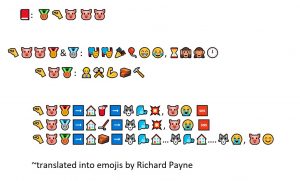
I started with a title which I knew to be simple for most people familiar with this story to figure out. I wanted it to be an easy one for people to get so that they could reflect on it from a place of familiarity. For this reason, I chose a work that is easily relatable to imagery. What surprised me in this exercise is how brief it could be, which could be incredibly advantageous. Furthermore, even without someone knowing this fable people in many cultures might be able to grasp the meaning quickly. The exception perhaps was for the limited way in which I had to depict the types of houses, for that I leaned on an image relying on the sound of the English word, which is ‘cheating’ a bit in that sense. For a simple fable such as this, imagery is extremely effective. Where the ideographic symbols starts to come apart is when we go deeper in expressing nuances, detail, and complex concepts. As we’ve seen throughout the readings in the development of written languages the ability to be able to break down words into basic building blocks is important to build up complexity into meaning. Symbols, while efficient for instantly conveying a whole meaning is however inevitably ineffective building out and pointing to specific complexities. The last book I read for example, in between my two MET courses, was Musashi, an old favourite. The thought of trying to summarize any given page of that book in emojis surely would be an injustice.

2 responses to “Task 6, An Emoji Story”